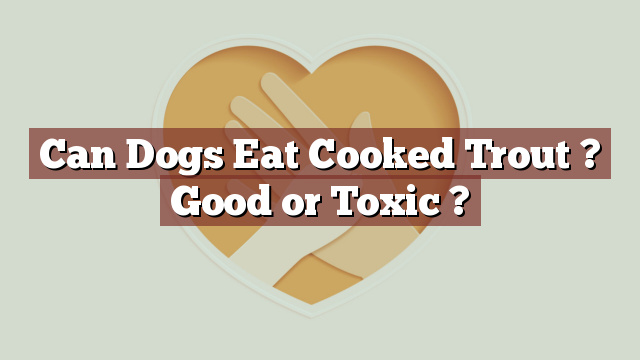Can Dogs Eat Cooked Trout? Good or Toxic?
Dogs are wonderful companions, and as responsible pet owners, it is crucial for us to ensure their well-being and provide them with a balanced and healthy diet. While it is tempting to share our meals with our furry friends, it is essential to be aware of what foods are safe for them to consume. In this article, we will explore whether cooked trout is a suitable food option for dogs, considering its nutritional value and potential risks.
Nutritional Value of Cooked Trout: Essential Facts for Dog Owners
Trout is a type of fish that is highly regarded for its nutritional value. It is packed with essential nutrients such as protein, omega-3 fatty acids, vitamin B12, and various minerals like selenium and phosphorus. These nutrients contribute to the overall health and development of dogs. Omega-3 fatty acids, for instance, play a vital role in maintaining a healthy coat and skin, as well as supporting cognitive function.
Can Dogs Safely Eat Cooked Trout? Expert Opinions and Research Findings
Yes, dogs can indeed safely eat cooked trout. According to veterinary experts and scientific research, cooked trout is generally considered safe for dogs to consume in moderation. However, it is crucial to note that a few precautions must be taken into consideration. First, the trout should be thoroughly cooked, as raw or undercooked fish may contain harmful bacteria or parasites that can cause digestive issues in dogs. Additionally, it is advisable to remove all the bones from the trout before feeding it to your furry companion, as fish bones can pose a choking hazard.
Potential Risks and Benefits of Feeding Cooked Trout to Dogs
The potential risks associated with feeding cooked trout to dogs are minimal when the proper precautions are taken. However, it is important to be aware that some dogs may have individual sensitivities or allergies to fish. If you notice any adverse reactions such as vomiting, diarrhea, or skin irritation after feeding your dog trout, it is recommended to discontinue the feeding and consult with a veterinarian.
On the other hand, the benefits of including cooked trout in your dog’s diet can be substantial. As mentioned earlier, trout is rich in omega-3 fatty acids, which can promote a healthy coat, reduce inflammation, and support cardiovascular health. The protein content in trout is also beneficial for muscle development and repair.
What to Do If Your Dog Eats Cooked Trout: Steps for Ensuring Safety
If your dog accidentally consumes cooked trout and you are unsure about its impact, here are a few steps you can take to ensure their safety:
- Monitor your dog: Observe your dog for any signs of discomfort, such as vomiting or diarrhea. If these symptoms persist or worsen, consult with a veterinarian.
- Check for bones: Ensure that there are no fish bones stuck in your dog’s throat or digestive tract. If you notice any unusual behavior, difficulty swallowing, or gagging, seek immediate veterinary attention.
- Introduce gradually: If you are introducing cooked trout into your dog’s diet for the first time, start with small portions to gauge their tolerance and any potential allergic reactions.
- Consult a veterinarian: If you have any concerns or questions about feeding cooked trout to your dog, it is always advisable to consult with a veterinarian who can provide personalized guidance based on your dog’s specific needs.
Conclusion: Balanced Approach to Including Cooked Trout in Your Dog’s Diet
In conclusion, cooked trout can be a healthy addition to your dog’s diet when prepared and fed properly. It is a valuable source of essential nutrients, including omega-3 fatty acids and protein. However, it is crucial to exercise caution and take appropriate measures to ensure your dog’s safety, such as cooking the fish thoroughly and removing all bones. If in doubt, consult with a veterinarian to ensure you are providing the best dietary options for your beloved furry friend.
Thank you for investing your time in exploring [page_title] on Can-Eat.org. Our goal is to provide readers like you with thorough and reliable information about various dietary topics. Each article, including [page_title], stems from diligent research and a passion for understanding the nuances of our food choices. We believe that knowledge is a vital step towards making informed and healthy decisions. However, while "[page_title]" sheds light on its specific topic, it's crucial to remember that everyone's body reacts differently to foods and dietary changes. What might be beneficial for one person could have different effects on another. Before you consider integrating suggestions or insights from "[page_title]" into your diet, it's always wise to consult with a nutritionist or healthcare professional. Their specialized knowledge ensures that you're making choices best suited to your individual health needs. As you navigate [page_title], be mindful of potential allergies, intolerances, or unique dietary requirements you may have. No singular article can capture the vast diversity of human health, and individualized guidance is invaluable. The content provided in [page_title] serves as a general guide. It is not, by any means, a substitute for personalized medical or nutritional advice. Your health should always be the top priority, and professional guidance is the best path forward. In your journey towards a balanced and nutritious lifestyle, we hope that [page_title] serves as a helpful stepping stone. Remember, informed decisions lead to healthier outcomes. Thank you for trusting Can-Eat.org. Continue exploring, learning, and prioritizing your health. Cheers to a well-informed and healthier future!

